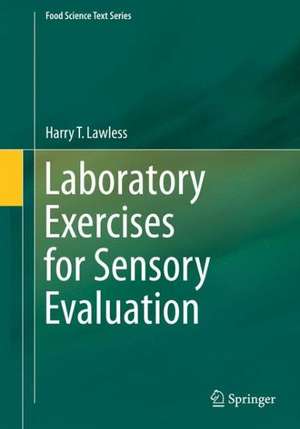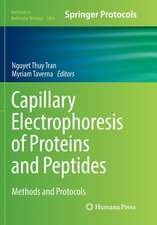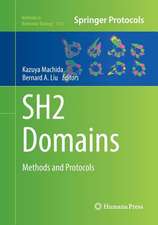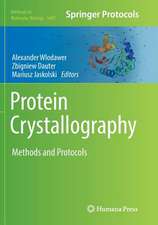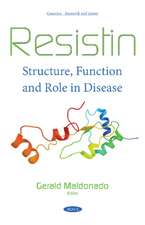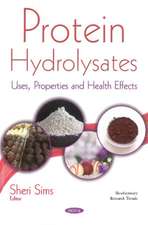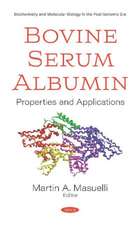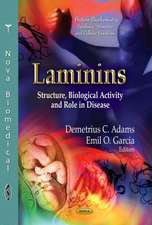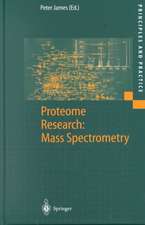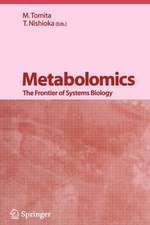Laboratory Exercises for Sensory Evaluation: Food Science Text Series, cartea 2
Autor Harry T. Lawlessen Limba Engleză Paperback – 11 dec 2012
Din seria Food Science Text Series
- 17%
 Preț: 502.95 lei
Preț: 502.95 lei - 17%
 Preț: 469.18 lei
Preț: 469.18 lei - 15%
 Preț: 549.39 lei
Preț: 549.39 lei - 20%
 Preț: 579.80 lei
Preț: 579.80 lei -
 Preț: 458.78 lei
Preț: 458.78 lei - 15%
 Preț: 566.10 lei
Preț: 566.10 lei - 13%
 Preț: 358.75 lei
Preț: 358.75 lei - 15%
 Preț: 635.75 lei
Preț: 635.75 lei -
 Preț: 396.40 lei
Preț: 396.40 lei -
 Preț: 482.23 lei
Preț: 482.23 lei -
 Preț: 392.37 lei
Preț: 392.37 lei -
 Preț: 398.35 lei
Preț: 398.35 lei - 15%
 Preț: 508.60 lei
Preț: 508.60 lei - 15%
 Preț: 508.75 lei
Preț: 508.75 lei - 15%
 Preț: 587.39 lei
Preț: 587.39 lei - 18%
 Preț: 965.83 lei
Preț: 965.83 lei -
 Preț: 393.13 lei
Preț: 393.13 lei - 15%
 Preț: 532.70 lei
Preț: 532.70 lei - 15%
 Preț: 593.26 lei
Preț: 593.26 lei -
 Preț: 474.31 lei
Preț: 474.31 lei - 15%
 Preț: 658.05 lei
Preț: 658.05 lei - 15%
 Preț: 600.74 lei
Preț: 600.74 lei - 18%
 Preț: 971.22 lei
Preț: 971.22 lei - 15%
 Preț: 477.74 lei
Preț: 477.74 lei - 18%
 Preț: 1010.33 lei
Preț: 1010.33 lei - 15%
 Preț: 477.74 lei
Preț: 477.74 lei
Preț: 574.25 lei
Preț vechi: 675.58 lei
-15% Nou
Puncte Express: 861
Preț estimativ în valută:
109.88€ • 115.03$ • 90.92£
109.88€ • 115.03$ • 90.92£
Carte tipărită la comandă
Livrare economică 05-19 aprilie
Preluare comenzi: 021 569.72.76
Specificații
ISBN-13: 9781461456827
ISBN-10: 1461456827
Pagini: 168
Ilustrații: XIV, 151 p. 16 illus., 2 illus. in color.
Dimensiuni: 178 x 254 x 17 mm
Greutate: 3.28 kg
Ediția:2013
Editura: Springer Us
Colecția Springer
Seria Food Science Text Series
Locul publicării:New York, NY, United States
ISBN-10: 1461456827
Pagini: 168
Ilustrații: XIV, 151 p. 16 illus., 2 illus. in color.
Dimensiuni: 178 x 254 x 17 mm
Greutate: 3.28 kg
Ediția:2013
Editura: Springer Us
Colecția Springer
Seria Food Science Text Series
Locul publicării:New York, NY, United States
Public țintă
Upper undergraduateCuprins
Section A. Introductory Material and General Instructions.- 1. Introduction for Students.- 2. Introduction for Instructors and Teaching Assistants.- Section B. Eleven Laboratory Exercises in Sensory Evaluation.- 3. Screening panelists using simple sensory tests.- 4. Comparison of discrimination test methods.- 5. Forced choice thresholds using an ascending method of limits.- 6. Signal Detection Theory and the Effect of Criterion on Response.- 7. Sweetness of fructose and sucrose determined by different scaling methods.- 8. Time-intensity scaling.- 9. Flavor Profile Method.- 10. Introduction to Descriptive Analysis.- 11. Use of Reference Standard in Panel Training.- 12. Acceptance and Preference Testing.- 13. Optimization by ad libitum Mixing and the Just-About-Right Scale.- Section C: Brief Exercises and Group Projects.- 14. Group Exercise in Descriptive Analysis.- 15. Brief exercises.- Section D. Statistical Problem Sets for Sensory Evaluation.- Chapter 16: Sample Problem Sets for Statistics.- Exercise 1. Means, standard deviations, standard errors.- Exercise 2. Binomial-based statistics for discrimination tests.- Exercise 3: The t-tests.- Exercise 4. Simple Correlation.- Exercise 5. One and two-way ANOVA.- Exercise 6. Planned comparisons of means following ANOVA.- Exercise 7. Rank order tests.- Appendix. Sample data sets and open tables for calculations.
Notă biografică
Harry T. Lawless is Professor Emeritus in the Department of Food Science, Cornell University.
Textul de pe ultima copertă
From the co-author of Sensory Evaluation of Foods, Principles and Practices, this lab manual is a fitting accompaniment to that text in an undergraduate or graduate course in sensory evaluation of foods. The manual includes introductory information, such as report formats (both academic and industrial), as well as a series of eleven full-length lab exercises suitable for a three-hour laboratory period. There are also four shorter exercises suitable for a traditional class period, and one group exercise suitable for a semester project in descriptive analysis and terminology building. Correct use of graphs, tables and statistics is emphasized in several sections. Each exercise includes both a student section and one for instructors and teaching assistants, which features detailed instructions with supplies, equipment, preparation procedures, ballots and data sheets. Each instructor section also includes “keys to successful execution,” which cover common mistakes and important details, designed to give the students the maximum opportunity for a rich learning experience. A group of statistical problem sets is included to reinforce common statistical analyses used with sensory data. Methods encountered include discrimination, descriptive, affective/hedonic, scaling, thresholds, panelist screening, shelf life and consumer questionnaires. Critical thinking and discussion questions are emphasized above and beyond the rote learning of a specific procedure. For classes that may be offered to less advanced students, suggestions are made in the instructor sections on how the exercise or report can be simplified. The exercises were compiled and refined over two decades and used in an upper level course in sensory testing at Cornell University.
Caracteristici
Complements the flagship textbook Sensory Evaluation of Foods Easily adaptable to coursework Includes problem sets
